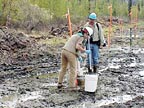
The key to collecting good aquifer test data revolves around collecting accurate water levels in the pumping well and surrounding observation wells. These water levels then are plotted on semi-logarithmic graph paper and analyzed according to widely accepted methods published in the literature to determine the aquifer’s unique characteristics.
Methods for determining water levels in wells have evolved over the last 30 years — from using chalk on metal measuring tapes and floats attached to tapes to electric tape measures and electronic pressure transducers, which measure the height (pressure) of the water above the sensor placed in the well. Transducers often are a good method to use to record water levels, however, at this time, they are slightly more expensive than the more popular electric tape method often used for single aquifer tests with only a limited number of observation wells.
The electric tape method probably is the most common method and is fairly simple. Two electrical wires are lowered into the well, and when water appears in the space between the barred wires, a small electrical current is conducted across the electrodes, which, in turn, activates a buzzer sound.
A number of problems can occur particularly in measuring water levels in pumping wells. The water level in a pumping well often draws down or falls very fast over a long distance, which can be difficult to measure rapidly, as often is required in the early stages of an aquifer test.
First of all, electric tapes rely upon the water quality in the well to be similar to drinking quality. If the fluid is very clean, such as that from a shallow sand aquifer or water of very low specific conductance (about 50 Ïmhos/cm or less), the current may not arc between the electrodes. Adding a few teaspoons of salt may help in this case. In wells contaminated with floating fuels, the fluid also will not readily conduct current (due to high resistance), and the fuel often will coat the electrodes.
Second, when a water level falls rapidly in a well, there are droplets of water throughout the area of drawdown. If the electrode encounters these droplets, false readings will occur, especially around couplings and pump wires. Also, measuring water levels below the top of a screen often is problematic because, once the water level is lowered below the top of the screen, water often drips or sprays into the well through the screen, and the probe doesn’t know the difference between spray and the water level surface. The same is true for leaks in the drop pipe pump column or casing. A small-diameter tube (1⁄2–inch) lowered to the top of the pump to place the probe in may do the trick.
Based on years of experience, no matter what method is used to measure water levels, plan on performing a trial pump test for approximately three minutes to five minutes at least a few hours before the actual test to determine how far and how fast the water levels will fall. This trial test will help identify unanticipated problems early, which then can be corrected before the long-term test begins.
Report Abusive Comment